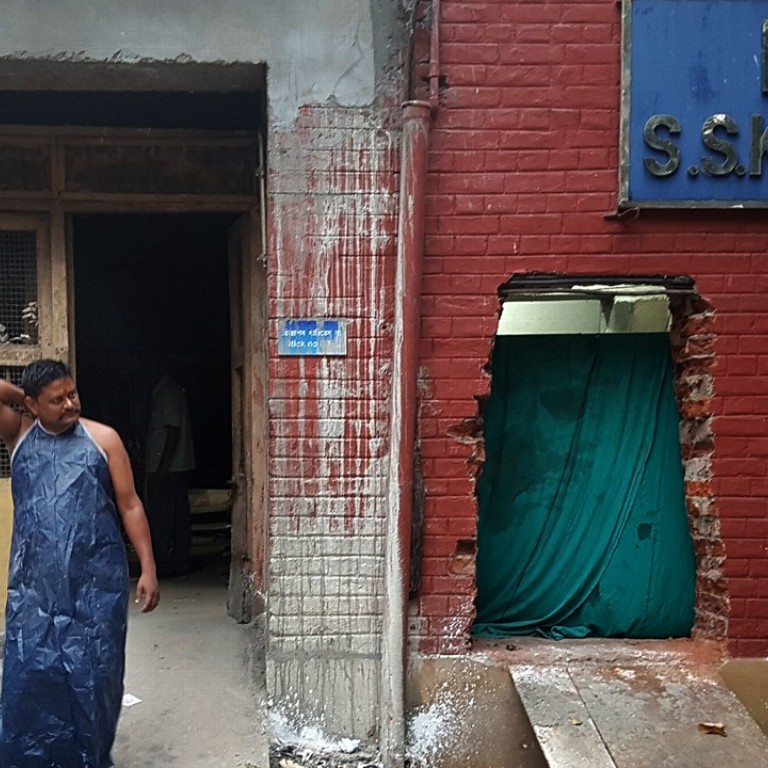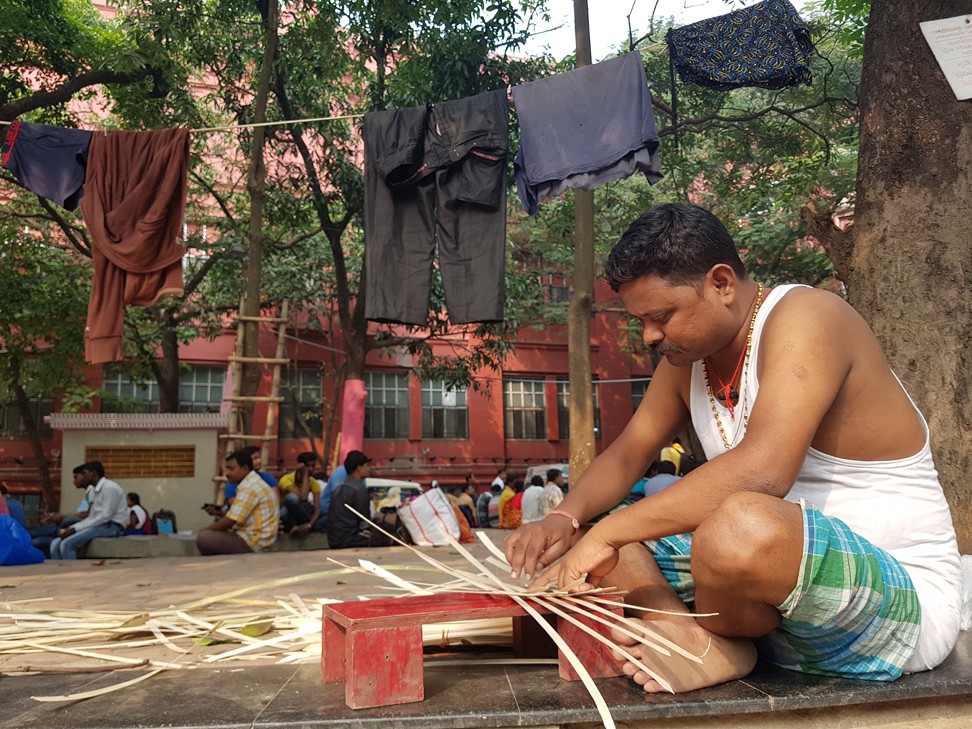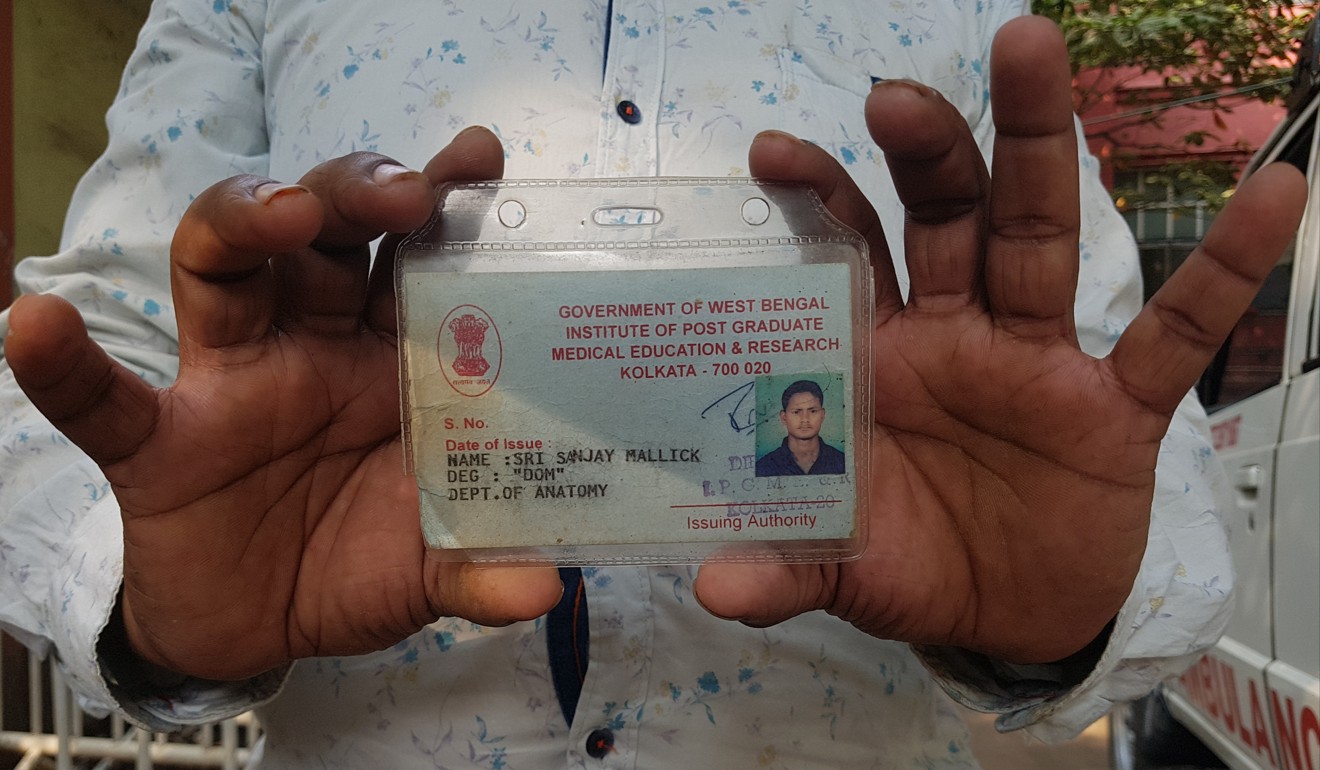
Keeping death in the family: an untouchable caste in India is vital to Kolkata’s mortuaries
- One clan of Doms – the caste of corpse burners – work in five government hospital mortuaries
- They have held these jobs for two or three generations
When Sanjay Mallick was eight years old, his class teacher Mrs Mukherjee summoned his father to school for a meeting. It was the first time Mr Mallick had been called to his children’s school, and he was worried. His three elder boys had never made trouble, and Sanjay, the youngest, was no worse than other eight-year-old boys.
“Mrs Mukherjee had asked the class to describe what our fathers did,” Sanjay recalled. “I stood up and said, ‘My father picks up dead bodies.’”
In her meeting with Sanjay’s father – whose job was transporting dead bodies to and from the morgue in a government hospital – she said she had never heard a child speak of a parent with such pride. “You take care of this boy,” she told Mr Mallick. “Keep an eye on him when he enters that difficult age, don’t let him run wild.”
Despite his pride in his father, Sanjay wanted to study hospital administration. He liked the hospital environment but wanted to be a boss. In the end though, he followed his father into the family business.
Deportation and detention: 3 million face statelessness in Assam
“I was in the second year of my English honours degree at South City College when my father died. His pension stopped, the money in the household dried up,” Sanjay said. “When a vacancy was advertised in my father’s department, I applied. I got the job. It’s not what I’d planned, but it’s not bad. I’ve known the hospital ever since I can remember. I got my father’s [residential] quarters, the one I grew up in with my brothers, where my mother and father lived and died.”
Sanjay was recruited as a dissection hall attendant at the Institute of Postgraduate Education and Medical Research, one of the busiest and most prestigious public hospitals in Kolkata. His job is to dissect cadavers under the instruction of medical science professors to help students understand the human anatomy. Since 2009, he has also served in the forensics department, which works on criminal cases.
“It was a promotion. Autopsies require more speed and efficiency, more experience, more character really,” Sanjay said matter-of-factly. “Cadavers that are dissected for anatomy class are usually undamaged bodies, preserved in formalin. They smell cleaner. In forensics, there are bodies that have been fished out of lakes two days after the person drowned, decompensation may have set in. There are accidents where the legs are crushed, sometimes the face is gone. You have to have seen something of the world to see these things, fortitude you might say.”

Before his father, Sanjay’s grandfather also transported bodies to and from the morgue. Yet Sanjay carries the same designation as his father and grandfather before him: Dom. In the Hindu caste system, the Doms are corpse burners. They wash the orifices and clean the body after death, dress it and prepare it for cremation.
The West Bengal government assigns the designation of Dom to all those who work on dead bodies, despite the term’s antiquated origins. In annual hospital reports, only the Doms are labelled by their caste name. This works also as a reservation: a government job restricted to communities listed as marginalised under India’s polarising system of positive discrimination.
THE MALLICKS
Sanjay Mallick’s is a storied family in Kolkata. Male relatives of Sanjay’s work as Doms in every one of the five government hospitals in Kolkata which have morgues attached to them, including the police morgues for investigations into “unnatural deaths”. In each hospital, Sanjay has a cousin, or an uncle, or a nephew. And these jobs, like Sanjay’s, were held by their fathers and grandfathers before them.
How is it that the members of one clan of Mallicks from a cluster of three neighbouring villages in Samastipur, Bihar, work as Doms in all five government morgues in Kolkata?
Bangladesh election: will Sheikh Hasina’s China-India balancing act be enough to keep power?
“I’ve always worked with a Mallick in my career. I don’t know how it is, but I have,” said BN Kahali, the head of the department of forensic sciences at IPGMER. “I started some 30 years ago. Before that I was a medical student. As far as I remember, the professor’s assistants were also Mallicks. We didn’t pay attention to these things really. We focused on medical science, on scientific findings. But I do know that we wouldn’t be able to do the work we do without the Doms. They can move 70, 80kg bodies, 70-80 kilos of deadweight literally.”
It is clear the Doms are indispensable to the medical system and society. When bodies are brought into the morgue, or brought out to be released, drivers, friends and even family members will refuse to lift it from the gurney into the waiting ambulance or hearse. A Dom from the hospital has to be called to do the job. When a Dom is not available, or cannot manage a body by himself, no one steps forward to help.
You know, they say that no work can be complete without the Doms. It’s unique, this work of ours
Some of this behaviour may be the inherent horror of death, but a large part is the legacy of the caste system. The social hierarchy deemed that not only was touching the dead polluting but also that those who worked with death, like the Doms, were untouchable.
Frequently, Sanjay intervenes when this argument plays out, requesting people to help. “Arrey, the body has to be loaded in, naa,” he will say. “But I don’t know how to handle a body,” will be the most vehement refusal. “It’s nothing, just give me a hand,” Sanjay will respond. He is always calm, gentle in his persuasion, but always regal. He cultivates the persona of an old king who knows the ways of the world but wants to push us to do the right thing.

In the hospital complex, people gravitate towards him for directions or help though there is no ID on his person or anything to suggest that he is an employee. Like his father before him, Sanjay, too, is a local politician, attending meetings of the local ruling party and putting up pictures of these on Facebook.
Invariably, arguments about touching a body end with a Dom or two coming out and doing the job when it is clear that no one will step in help. Then, there is a collective sigh of relief. This is why Sanjay Mallick is given residential quarters inside the hospital, in an area where real estate is limited and valuable. He, as with any Dom, is expected to be on duty all day and all night. A body can come in at any moment.
Malaysia refuses to back down over Singapore boundary disputes
“In Maharashtra, we do not have a Dom classification,” said Indrajit Khandekar, a professor of forensic medical science at the Mahatma Gandhi Institute of Medical Sciences, Wardha. “The sweepers or attendants do the job of forensic assistants. They are mostly from the untouchable castes, Mahars and Bhangis. We don’t have trained medical technologists. The section on forensics in the Code of Criminal Procedure was introduced in 1898, and has almost never been amended since then. Whatever few amendments have been made have not made their way to medical schools. So that’s 120 years and counting of one law.”
INDISPENSABLE ‘UNTOUCHABLES’
In 1836, Madhusudan Gupta performed the first dissection of a human cadaver in Asia at the Medical College and Hospital in Kolkata.
Outside the hospital, a crowd had gathered in protest at this unholy act and the administration secured the gates and guarded them.
It is said that Fort William, the British settlement in Kolkata, performed a 50-gun salute to honour the achievement. It was a big moment, a member of the highest caste cutting open a dead body.
Medical College and Hospital is known to be the second Western medical school in India, following the establishment of Ecole de Medicine in Pondicherry by the French in 1822-23. In those early years, there were dissections only for the purpose of helping medical students understand the human body. These were few in number, mostly performed by doctors and students, occasionally by their British instructors as well. Medical students, too, were few and far between.
The need to handle cadavers in larger numbers likely began in 1898 when the forensic section of the Code of Criminal Procedure was instituted by the British. The police were now required to investigate unnatural deaths, including accidents, suicide and homicide, leading to a greater need for handlers to transport dead bodies.

Perhaps this is when the Doms first started to be hired in the medical hierarchy. There were too few doctors and medical science students. Besides doctors would dissect bodies, not lug them from place to place.
A curious contradiction took shape: as modern Western medical science was instituted in India, a traditional caste occupation was inducted into the hospital hierarchy. If there was a gun salute when the first Dom helped cut open a cadaver, there is no mention of it in the history books.
“There is mention of us in the Mahabharata,” Sanjay said, referring to the ancient Indian epic. “The story goes that when the battle of Kurukshetra was over, the gong to signal the end of the war could not be heard because our Dom guru Supan Sudarshan Bhakt was not invited by the Pandavas [the king’s sons] for the feast of celebration. When Krishna reminded Draupadi, and she invited our guru and fed him with care, the gong rang out on its own. You know, they say that no work can be complete without the Doms. It’s unique, this work of ours.”
Life after IS: Philippines faces its next battle – rebuilding Marawi
EVEN GHOSTS NEED ENDINGS
Death has been on my mind for a long time.
Late last year, my grandmother was diagnosed with advanced bowel cancer. At the beginning of this year, my father slipped into a coma with a failing liver. He received an emergency transplant from my mother, who donated 60 per cent of her liver to him. I was in a distant city, sleepless, while both of my parents were in the intensive care unit.
Two days later, my grandmother died. When I received the news, I was told not to share it with my parents. On the telephone, my aunts said my grandmother’s body was soft hours after her death, so soft that she felt like a baby in their hands as they bathed her and dressed her in a sari for the cremation.
One day I found myself lying to Sanjay, telling him that I bathed my grandmother after she passed. There was no rigor mortis, I said, she was soft like a baby. That night I dreamed my father was dead. He had had a good transplant, recovered well, and was alive. But in my dream he was dead. I shared the news with people whose faces I didn’t remember. The next night, I dreamed again, and
again my father was dead. But why? people asked. He was well, and now he is dead, I replied.
The next day I told Sanjay I had lied. I didn’t see my grandmother when she died.
I’m not sure why I lied. He listened to me, and nodded. Not a knowing nod, but a sweet, earnest nod, like that of a schoolboy.
“Come to us on Sunday,” he said. “We are doing a bhoot puja [prayer ritual] in the
morgue. There is a way to end everything. Even ghosts need endings.”
“We know these things.”
Reporting for this story was conducted as part of the National Geographic Society’s Out of Eden walk.

